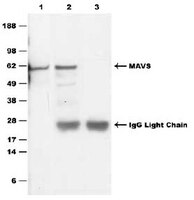ST1116 Sigma-AldrichAnti-MAVS Rabbit pAb
Recommended Products
Overview
| Replacement Information |
|---|
Key Specifications Table
| Host |
|---|
| Rb |
| Product Information | |
|---|---|
| Form | Liquid |
| Formulation | In Tris-citrate/phosphate buffer, pH 7-8. |
| Positive control | Saos-2 cells |
| Preservative | ≤0.1% sodium azide |
| Physicochemical Information |
|---|
| Dimensions |
|---|
| Materials Information |
|---|
| Toxicological Information |
|---|
| Safety Information according to GHS |
|---|
| Safety Information |
|---|
| Product Usage Statements |
|---|
| Packaging Information |
|---|
| Transport Information |
|---|
| Supplemental Information |
|---|
| Specifications |
|---|
| Global Trade Item Number | |
|---|---|
| Catalog Number | GTIN |
| ST1116 | 0 |
Documentation
References
| Reference overview |
|---|
| Seth, R.B., et al. 2005. Cell 122, 669. McWhirter, S.M., et al. 2005. Cell 122, 645. Meylan, E., et al. 2005. Nature 437, 1167. Kawai, T., et al. 2005. Nat. Immunol. 6, 981. Sun, Q., et al. 2006. Immunity 24, 633. |
Brochure
| Title |
|---|
| Biologics 33.2 |








